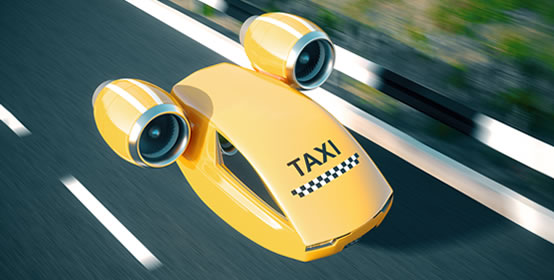
In densely populated cities, many residents don't even own cars—parking can cost hundreds of dollars per month, public transit is usually pretty robust, and traffic can turn streets into parking lots several times a day. Flying taxis are put forth as a solution to this, as they would be able to deliver riders from rooftop to rooftop, offering a quick, easy transit situation that completely skips over the gridlocked streets. But how? And is it really feasible?
The idea of a flying taxi might seem like something out of a mid-century science fiction flick, or, at the very least, something economically far out of reach of the average person. After all, planes take a lot of preparation between flights, and fuel is expensive. However, though widespread use might still be years away, the first flying taxi prototypes have already made it into the air. Part of the problem with conventional air travel is its expense—both monetary and economic. Jets have an enormous carbon footprint, but this may not be an issue for flying taxis. Airbus' eVTOL (electric vertical takeoff and landing) craft is a small, light aircraft with an all-electric motor, which skips neatly over many of the problems inherent in relying on fuel.
Though the prospect might sound daunting, most plans for small, commuter aircraft nix pilots entirely. Considering they are only intended for very short hops and that drone AI is already at the point where it requires minimal input from a human, setting up an automated flying taxi system isn't as far-fetched as it might sound. Though automated cars have hit a number of programming snags, aircraft have a notable advantage here: little-to-no traffic at the altitudes at which they operate.
More and more businesses are pouring money and manpower into flying taxis as a concept, which wouldn't be happening if they didn't expect to get a return on their (considerable) investment. Even Uber, makers of the ride share app, is partnering with multiple companies to help turn these small commuter aircraft into a reality. Even the executive vice president for Bell's commercial helicopter sales anticipates the first air taxi taking off by 2025.
As good as they look on paper, flying taxis may still be quite awhile away. Airbus plans to deploy its CityAirbus by 2023, but that goal may be a bit ambitious. (So far, the only evidence of the eVTOL craft working at all is a video of it hovering for 53 seconds.) That said, the biggest bar to flying taxis might not be the technology itself at all. Regulatory bodies have very high standards for aircraft, and that's a big part of why air travel has such great statistics when it comes to safety. Since these small commuter aircraft rely heavily on innovative technology, there aren't any precedents for them. The Federal Aviation Administration doesn't have any regulations in place governing safety standards for flying taxis, something that is going to be absolutely essential before a single one makes its maiden voyage with passengers on board in the United States. Getting approval is no small matter, either—it'll require several years and millions of dollars to achieve on its own, even outside of the research and development of the crafts themselves.
Whether flying taxis represent an innovative way to reduce congestion and cut down on fossil fuel emissions, or just a way for the “haves” to get to meetings while the “have nots” sweat it out on the bus, it's obvious that their investors and researchers predict a bright future for them. Though the 2025 timeline may be a bit ambitious, and the FAA may drag its feet when it comes to approving new technology for an unprecedented use, the industry seems fully committed to putting flying taxis in the air.